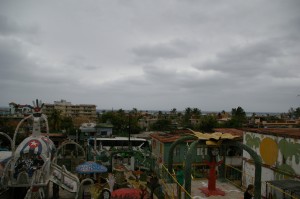Tourism in Residential Communities
May 4, 2012 by macarr
While in Cuba, as we traveled around with our large bus and our large group, I was always intensely aware of my status as a tourist. But many of the places we visited were not isolated tourist spots, but people’s homes and communities. Everywhere in Havana there were residences right beside popular tourist areas. But two residential communities we visited where I felt intensely like an intruding tourist were the Jose Fuster artists’ residence and the Las Terrazas community.
Fuster’s home/workshop was incredibly beautiful. He calls Pablo Picasso his “spiritual father” and Antoni Gaudi his “favorite uncle”. He states that his motive for creating the multicolored environment is to make a place where he can “live among art”. The day we visited, the vibrant, tiles shone beautifully against the gray, overcast sky. But Fuster’s home and workshop was located in the off the beaten path neighborhood of Jaimanitas, smack in the middle of a residential area on the outskirts of Havana that, if Fuster was not drawing tourists by the busload, seemingly would be largely ignored by the tourist gaze. Fuster says that his project “involves all my neighbors”, that his neighbors are his “partners”, but there was one particular moment as we were leaving that made me question that statement, and made me incredibly aware of my presence as a tourist in this neighborhood. The streets of Jaimanitas were very narrow, which required a deft bit of driving from Duniel to turn the bus around so that we could head back to the Hotel Plaza. But this took a few minutes, and while he was inching the bus around, I noticed a woman standing in her backyard, watching us. I saw in her eyes a feeling of disdain. She was obviously anything but pleased with the presence of the massive tourist bus in her community, and I felt like a burden and an interloper.
A second experience with being a tourist in the middle of people’s lives was at the Las Terrazas Community. It was wonderful to see the old coffee mills and terraces and the beautiful landscape of the biosphere, but I felt terribly like an intruder when we went near the actual community residences to shop for gifts and enjoy a coffee. Even though I was well aware that the tourist CUCs we spent in the little shop would benefit the members of the community, I still felt distinctly that the lives of the Las Terrazas residents would probably be better if they didn’t have groups of 50 or so tourists coming through their community daily on massive buses and photographing their homes, their pets, even their laundry lines.
These are two experiences that have stuck with me. I’ve tried to imagine how quickly I would tire of busloads of tourists walking through my backyard in suburbia. Luckily for me, none of my neighbors are famous artists, and the nearest popular sights for tourists are miles away. But I still vividly remember the piercing eyes of the woman in Jaimanitas as she stood outside of her home and stared down our bus. I only hope that she at least sees some form of profit from the wave of tourists who daily invade her neighborhood.
Source:
http://www.havana-cultura.com/en/nl/visual-art/jose-fuster/cuban-artist-painter-and-sculpture
Leave a Reply
You must be logged in to post a comment.
